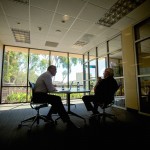This is the last installment of a ten part series by Dr. Scott Sunquist on what trends in missiology we can expect in the coming years.
Conclusion: Hope and Future
Scott W. Sunquist
When we look at these eight trends it is easy to turn melancholy. The ubiquity of technology can be seen as a rising idolatry; in fact, for some it is. As we try to connect with other people “in person,” say talking to a person on the plane or in a bus station, we often find out that they are already connected to YouTube, Vimeo, movies, or listening to music. Personal encounters are blocked by technological fixations. Technology is our ever present reality. We need to be connected, tuned into our devices. This is part of our missional context.

Similarly, we might look at insider movements as moving the church away from orthodox understandings of the Church, or of what it means to give our absolute and undying loyalty to Jesus Christ. Has such a thing ever happened before? Are insider movements an ecclesial and Christological compromise? And what about calling people to be pre-emptive peacemakers? Aren’t we really asking people to risk their lives living in places with the most conflict and potential violence? In addition, so many of these themes make it difficult for western Christians to find their place in the future of God’s mission. Is there are place for the highly motivated American or European? These and other themes seem so dark, dangerous, and depressing. Many of us (not wanting to admit it) may long for the days of colonial or semi-colonial missions when there were clearer lines regarding safety and orthodoxy; times when a friendship really meant sitting down and sipping tea and talking to each other (in the same country and even the same room).
But mission has always been full of such ambiguities and dangers. The double meaning of marturia as both witness and martyr is our guide now as it has been from the beginning. Pneumatic developments in Christianity around the world should be one of the guiding themes for Christian mission. Moving from technique and strategy to spirituality and power is, I propose, a recovery of earlier forms of Christianity that were neutralized by Enlightenment assumptions, and forgotten because of Christendom realities. Something must die in our western mission assumptions in order for a resurrection of Christian mission to come about. Christianity will flourish in the future almost solely in nations and cultures that are opposed to Jesus or are pluralistic. No longer will it flourish in Christendom cultures and contexts.
And yet, with all of the exciting developments in Christianity in the recent history, and all of the developments we look forward to, we must remember that the percentage of Christians in the 20th century declined slightly (34.8% to 33.2%). God was doing great new things, but for the future we might surmise that deeper prayer, reflection and commitment are called for, keeping in mind the eight themes mentioned above.
Worship and mission are the two great purposes of the Church. Worship must flow out into mission, and mission should always lead to thanksgiving and worship. All of the nations are to be included and all of the tears are to be wiped away. Innovation in mission must always be pulled forward by the future vision. Another way of saying this is that missiology that tracks the current trends must be grounded in eschatology (Revelation 7:9-17). When all is studied and evaluated, God’s future will be embodied by the humble, gentle, faithful and the unsuspecting. Both worship and mission are grounded in that future vision of the nations around the throne with a Lamb who was slain. And so we lay down our lives, not for our vision or plans, but for this divine vision of the total redemption of creation.
Dr. Scott W. Sunquist is the dean of the School of Intercultural Studies and professor of World Christianity at Fuller Theological Seminary.
This blog post was taken from The State of Missiology Today by Charles E. Van Engen. Copyright (c) 2016 by Charles E. Van Engen. Used by permission of InterVarsity Press, P.O. Box 1400, Downers Grove, IL 60515-1426.www.ivpress.com. Pre-order the full book here (expected October 2016).
Follow Fuller Seminary on Twitter: @fullerseminary
Follow Fuller’s School of Intercultural Studies on Twitter: @fuller_sis











